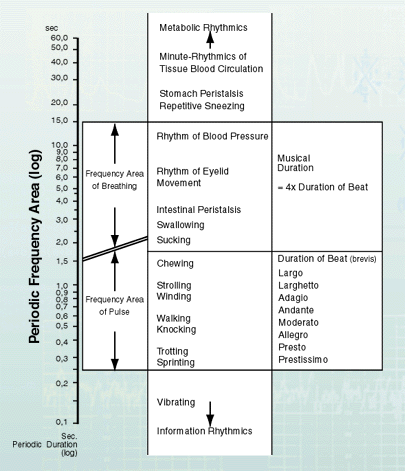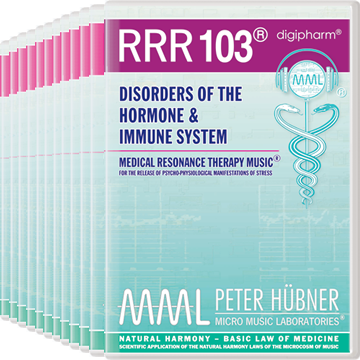|
Scientific Music Medicine |
| Home • Site Map • Research • Reports • Intern. Experts • Music Preparations • Fundamentals • Store • Contact |

Prof. Dr. med. Gunther Hildebrandt • Chronobiological Aspects of Music Physiology
In view of their central position in the total spectrum of the autonomic rhythms it comes as no surprise that the functional areas of breathing and pulse rhythm are in an especially close relationship to musical experience and musical movement.
As illustration 19 (middle column) shows, these areas practically include all unconscious, half-conscious and conscious rhythms of motor action. These continue on the one hand to the strictly harmonically regulated metabolic rhythms, on the other hand into the high frequency area of the frequency modulated processes of information rhythmics.
At the same time, the frequency areas of the pulse and breathing cover the area in which we have the immediate capability of feeling rhythms. Here, the frequency area of modulation of the pulse rhythm is in accordance with the area of all possible musical tempi (length of beat), while the range of variations of the breathing frequency is in accordance with the lengths of time in music.
Hereby, the original temporal ratio of length of time in music and length of beat of 4:1 is taken as a basis, as was substantiated in the early stages of musical notation development in obvious dependence on the normal frequency ratio of breathing and heart beat.
The fact that, in later times, too, the musical tempi were still related to the central rhythmic functions of heartbeat and breathing, is widely known. Until this day we speak of three-four time, although three quarters do not make a whole.
From illustration 19 we can also see that the sensation of tones must be classified as belonging to the field of information rhythmics, in which, once again, the conformity to the natural laws of harmonic orders take effect.
As illustration 19 (middle column) shows, these areas practically include all unconscious, half-conscious and conscious rhythms of motor action. These continue on the one hand to the strictly harmonically regulated metabolic rhythms, on the other hand into the high frequency area of the frequency modulated processes of information rhythmics.
At the same time, the frequency areas of the pulse and breathing cover the area in which we have the immediate capability of feeling rhythms. Here, the frequency area of modulation of the pulse rhythm is in accordance with the area of all possible musical tempi (length of beat), while the range of variations of the breathing frequency is in accordance with the lengths of time in music.
Hereby, the original temporal ratio of length of time in music and length of beat of 4:1 is taken as a basis, as was substantiated in the early stages of musical notation development in obvious dependence on the normal frequency ratio of breathing and heart beat.
The fact that, in later times, too, the musical tempi were still related to the central rhythmic functions of heartbeat and breathing, is widely known. Until this day we speak of three-four time, although three quarters do not make a whole.
From illustration 19 we can also see that the sensation of tones must be classified as belonging to the field of information rhythmics, in which, once again, the conformity to the natural laws of harmonic orders take effect.

Illustration 19
The frequency areas of breathing and heart rhythm in their relation to rhythmic functions, mainly to motor action rhythms, as well as to the musical rhythms.
(According to HILDEBRANDT 1990, amended)
| MEDICAL RESONANCE THERAPY MUSIC® Medical Music Preparations on CD |
| Listening Program: Disorders of the Hormone & Immune System 
|
|
If you like to look at the complete program, |
With kind permission of AAR EDITION INTERNATIONAL
© 1998- SCIENTIFIC MUSIC MEDICINE | Contact
Subject to change in the interests of scientific advancement.
© 1998- SCIENTIFIC MUSIC MEDICINE | Contact
Subject to change in the interests of scientific advancement.